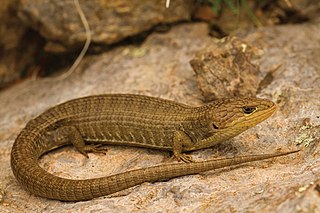
Anguidae refers to a large and diverse family of lizards native to the Northern Hemisphere. Common characteristics of this group include a reduced supratemporal arch, striations on the medial faces of tooth crowns, osteoderms, and a lateral fold in the skin of most taxa. The group is divided into two living subfamilies, the legless Anguinae, which contains slow worms and glass lizards, among others, found across the Northern Hemisphere, and Gerrhonotinae, which contains the alligator lizards, native to North and Central America. The family Diploglossidae was also formerly included. The family contains about 87 species in 8 genera.

Abronia is a genus of lizards in the family Anguidae that is native to Mexico and Central America. The majority of the species are restricted to southern Mexico and Guatemala, but members of the genus occur as far south as Panama. They inhabit forests and woodlands, mostly in highlands, and some species are often associated with bromeliads. They are typically arboreal, but there are also terrestrial Abronia species. Many species are considered threatened due to habitat loss, killing by locals who mistakenly believe they are venomous, or collection for the captive reptile trade. They feed on small animal prey, such as insects, and the females give birth to live young.

Barisia is a genus of lizards in the family Anguidae. The genus is endemic to Mexico.

Elgaria is a genus of New World lizards in the family Anguidae. Their common name is western alligator lizards.

Gerrhonotus is a genus of anguid lizards that are commonly referred to as alligator lizards, due to a vague resemblance to an alligator. Most species are restricted to Mexico, but a few range into Guatemala or Texas, and G. rhombifer is from Costa Rica and Panama. Along with glass lizards (Ophisaurus) and many other lizards, alligator lizards have the ability to regrow their tail.

The southern alligator lizard is a common species of lizard in the family Anguidae. The species is native to the Pacific coast of North America. It ranges from Baja California to the state of Washington and lives in a variety of habitats including grasslands, chaparral, forests, and even urban areas. In dry climates, it is likely to be found in moist areas or near streams. There are five recognized subspecies.

Arend Friedrich August Wiegmann was a German zoologist and herpetologist born in Braunschweig.
An alligator lizard is any one of various species of lizards in the family Anguidae that have some shared characteristics. The term may specifically refer to:

The Panamint alligator lizard is a species of lizard in the Anguidae family.

Abronia deppii, Deppe's arboreal alligator lizard, is an endangered species of arboreal alligator lizard in the family Anguidae. The species was described in 1828 by Arend Friedrich August Wiegmann, and it is endemic to Mexico.

Abronia matudai, Matuda's arboreal alligator lizard, is a species of endangered arboreal alligator lizard in the family Anguidae. The species, which was originally described in 1946 by Norman Hartweg and Joseph Tihen, is endemic to Central America.

Abronia ochoterenai, Ochoterena's arboreal alligator lizard or Northern Chiapas arboreal alligator lizard, is a species of arboreal alligator lizard in the family Anguidae. The species, which is native to extreme southern Mexico, was described in 1939 by Rafael Martín del Campo.
The isthmian alligator lizard is a species of lizard of the Anguidae family. G. rhombifer is found in both Costa Rica and Panama. Unlike many lizards near its habitat, individuals have lateral folds. They give birth to live young. Gerrhonotus rhombifer had not been seen for fifty years, prior to being rediscovered in 2000 near Golfito, and is one of the rarest species of lizard in Costa Rica.
Cope's arboreal alligator lizard is a species of lizard found in two isolated locations in Guatemala, one in the Alta Verapaz Department and one in the Jalapa Department. These lizard are found only in high altitudes of 2,000 to 2,600 feet above sea level, on the west and south sides of the mountain ranges. This lizard is one of 28 species of alligator lizards, most being arboreal, meaning they live in trees. These omnivores are considered endangered because of their small population size and they face extinction due to habitat degradation and from pressures of the pet trade.

The Madrean alligator lizard is a species of lizard in the family Anguidae. The species is endemic to the southwestern United States and adjacent northwestern Mexico.
Gerrhonotus farri, also known commonly as Farr's alligator lizard and the Tamaulipan alligator lizard, is a species of lizard in the family Anguidae. The species is native to northeastern Mexico.

Gerrhonotus liocephalus, the Texas alligator lizard or Wiegmann's alligator lizard, is a species of lizard of the Anguidae family. It is found in Texas, Mexico and Guatemala.

Abronia gadovii, also known commonly as Gadow's alligator lizard and el escorpión de Gadow in Mexican Spanish, is a species of lizard in the family Anguidae. The species is endemic to the highlands of the Sierra Madre del Sur in Guerrero and Oaxaca, Mexico. Two subspecies are recognized:
The Cedros Island alligator lizard is a species of medium-sized lizard in the family Anguidae. The species is endemic to Mexico.



















